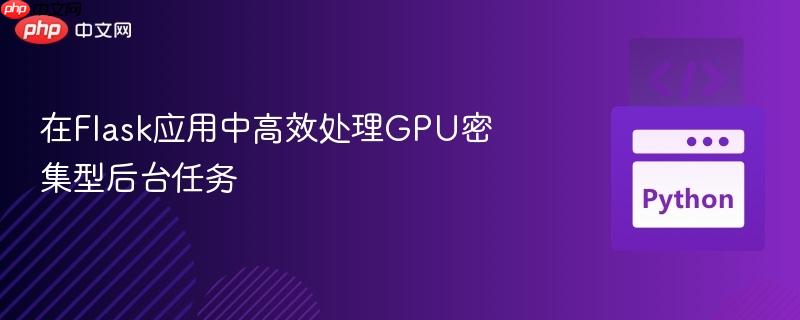
本文旨在解决Python Flask服务器在处理GPU密集型任务时出现的阻塞问题。通过深入分析服务器请求处理机制与任务并发执行器的协同工作,文章提供了多种解决方案,包括启用Flask开发服务器的多线程模式、合理使用`ProcessPoolExecutor`或`ThreadPoolExecutor`进行任务卸载,以及探讨生产环境下的WSGI服务器配置。最终目标是实现客户端请求的即时响应,同时确保耗时任务在后台高效运行。
在构建Web服务时,尤其当服务需要执行如图像/视频分析等GPU密集型、耗时较长的任务时,如何确保服务器的响应性和并发处理能力成为关键挑战。一个常见的场景是,客户端发送请求后,即使服务器将重型任务提交到后台执行器,客户端仍然会长时间等待响应,这表明服务器本身在请求处理层面存在阻塞。本教程将深入探讨这一问题,并提供一系列解决方案。
当一个Flask应用接收到请求时,它会通过其底层的WSGI服务器(开发环境通常是Werkzeug自带的服务器)来处理。即使我们使用了concurrent.futures模块中的ProcessPoolExecutor或ThreadPoolExecutor将耗时任务提交到后台执行,如果WSGI服务器本身是单线程或单进程的,它在处理完当前请求并发送响应之前,就无法接受和处理新的客户端请求。
具体来说,EXECUTOR.submit(apply_algorithm, file)会立即返回一个Future对象,但这并不意味着HTTP请求处理流程就此结束。服务器仍然需要等待analyze路由函数执行完毕,并返回JSON响应给客户端。如果服务器在等待当前请求的整个生命周期中阻塞了后续请求,那么即使后台任务正在并行执行,客户端仍然会感受到延迟。
在尝试复杂的解决方案之前,首先进行问题诊断至关重要。我们可以将实际的GPU密集型任务替换为一个简单的time.sleep()调用,以模拟其耗时特性,从而判断阻塞是来源于任务本身还是服务器的请求处理机制。
import time
def apply_algorithm(file):
"""
模拟GPU密集型算法,耗时约70秒。
"""
print(f"开始处理文件: {file}")
time.sleep(70) # 模拟耗时操作
print(f"文件 {file} 处理完成")
return f"Processed {file}"通过这种方式,如果客户端仍然等待70秒,则可以确认问题出在服务器的请求处理并发性上。
对于开发环境,Flask自带的Werkzeug服务器默认是单线程的。我们可以通过在app.run()中设置threaded=True来启用多线程模式,使其能够同时处理多个客户端请求。
# server.py (modified)
import json, logging
from concurrent.futures import ProcessPoolExecutor, ThreadPoolExecutor
from flask import Flask, request
import time # 用于模拟任务
logging.basicConfig(format='[%(asctime)s] %(message)s', datefmt='%Y-%m-%d %H:%M:%S', level=logging.INFO)
app = Flask(__name__)
# 根据任务类型选择合适的执行器
# 对于GPU任务,通常会释放GIL,ThreadPoolExecutor可能足够
# 但如果任务包含CPU密集型预处理或后处理,ProcessPoolExecutor更佳
EXECUTOR = ProcessPoolExecutor(max_workers=4) # 可以指定工作进程/线程数量
def apply_algorithm(file):
# 模拟GPU相关算法 -- 图像/视频分析 (非常耗时的任务)
print(f"[{time.ctime()}] 开始处理文件: {file}")
time.sleep(70) # 模拟GPU任务耗时
print(f"[{time.ctime()}] 文件 {file} 处理完成")
return f"Analysis complete for {file}"
@app.route('/analyze', methods = ['POST'])
def analyze():
file = request.form['file']
message = None
try:
# 提交任务到后台执行器,立即返回Future对象
EXECUTOR.submit(apply_algorithm, file)
message = f'Processing started for {file}!'
logging.info(message)
except Exception as error:
message = f'Error: Unable to analyze {file}!'
logging.warning(f"Error submitting task for {file}: {error}")
status = {'status': message}
# 立即返回响应给客户端
return json.dumps(status)
if __name__ == "__main__":
# 启用多线程模式,允许服务器同时处理多个请求
app.run(debug=True, host='0.0.0.0', port=5000, threaded=True)客户端代码 (client.py):
import requests
import time
def send_request(host, port, file):
url = f'http://{host}:{port}/analyze'
body = {'file': file}
print(f"[{time.ctime()}] Sending request for {file}...")
try:
response = requests.post(url, data = body, timeout=5) # 设置一个较短的超时,因为服务器应立即响应
status = response.json()['status']
print(f"[{time.ctime()}] Received response for {file}: {status}")
except requests.exceptions.Timeout:
print(f"[{time.ctime()}] Request for {file} timed out, but server should have responded.")
except Exception as e:
print(f"[{time.ctime()}] Error sending request for {file}: {e}")
if __name__ == "__main__":
# 模拟多个客户端并发请求
import threading
files = ["test1.h5", "test2.h5", "test3.h5"]
threads = []
for f in files:
t = threading.Thread(target=send_request, args=("localhost", 5000, f))
threads.append(t)
t.start()
time.sleep(0.1) # 稍微错开请求时间
for t in threads:
t.join()
print(f"[{time.ctime()}] All client requests sent and processed (or timed out).")注意事项:
在生产环境中,我们不应依赖Flask的开发服务器。专业的WSGI服务器(如Gunicorn或uWSGI)提供了强大的并发处理能力,通过多进程或多线程模型来管理请求。
例如,使用Gunicorn部署Flask应用:
gunicorn -w 4 -k gevent -b 0.0.0.0:5000 server:app
这里:
Gunicorn的工作进程会独立地接收和处理请求。当一个请求到达并被提交到ProcessPoolExecutor后,该工作进程会立即返回响应,并准备好接收下一个请求,而后台的GPU任务则在ProcessPoolExecutor中异步执行。
如果不想使用Flask框架,或者需要更底层地控制HTTP服务器,可以直接使用Python标准库中的http.server.ThreadingHTTPServer。这能更直观地展示多线程服务器如何处理并发请求。
import json, logging
from concurrent.futures import ProcessPoolExecutor
from http.server import BaseHTTPRequestHandler, ThreadingHTTPServer
import socketserver
import time # 用于模拟任务
logging.basicConfig(format='[%(asctime)s] %(message)s', datefmt='%Y-%m-%d %H:%M:%S', level=logging.INFO)
# 设置TCP服务器的请求队列大小,防止连接被拒绝
socketserver.TCPServer.request_queue_size = 100
EXECUTOR = ProcessPoolExecutor(max_workers=4)
def apply_algorithm(file):
print(f"[{time.ctime()}] 开始处理文件 (ThreadingHTTPServer): {file}")
time.sleep(70) # 模拟GPU任务耗时
print(f"[{time.ctime()}] 文件 {file} 处理完成 (ThreadingHTTPServer)")
return f"Analysis complete for {file}"
class FunctionServerHandler(BaseHTTPRequestHandler):
def do_POST(self):
content_len = int(self.headers.get('Content-Length'))
post_body = self.rfile.read(content_len)
data = json.loads(post_body.decode('utf-8'))
file = data.get("file")
try:
# 提交任务到后台执行器,并立即返回响应
EXECUTOR.submit(apply_algorithm, file)
message = f'Processing started for {file}!'
self.send_response(200)
self.send_header('Content-type', 'application/json')
self.end_headers()
self.wfile.write(json.dumps({"status": message}).encode('utf-8'))
self.wfile.flush()
logging.info(message)
except Exception as error:
message = f'Error: Unable to analyze {file}!'
logging.warning(f"Error submitting task for {file}: {error}")
self.send_response(500)
self.send_header('Content-type', 'application/json')
self.end_headers()
self.wfile.write(json.dumps({"status": message}).encode('utf-8'))
self.wfile.flush()
def log_message(self, format, *args):
# 禁用默认的HTTP请求日志,以免与自定义日志混淆
return
if __name__ == "__main__":
host = "0.0.0.0"
port = 5000
print(f"[{time.ctime()}] Starting ThreadingHTTPServer on {host}:{port}")
httpd = ThreadingHTTPServer((host, port), FunctionServerHandler)
httpd.serve_forever()这个示例展示了如何使用ThreadingHTTPServer来构建一个多线程的HTTP服务器,每个请求都在一个独立的线程中处理。这与Flask的app.run(threaded=True)原理类似,但提供了更精细的控制。
解决Flask服务器处理GPU密集型后台任务的阻塞问题,关键在于同时解决两个层面的并发性:服务器请求处理的并发性和后台任务执行的并发性。通过在开发环境中使用app.run(threaded=True),在生产环境中使用专业的WSGI服务器(如Gunicorn),并结合ProcessPoolExecutor或ThreadPoolExecutor来卸载耗时任务,可以确保服务器能够即时响应客户端请求,同时高效地在后台执行重型计算。合理的资源管理、错误处理和任务结果通知机制也是构建健壮系统的不可或缺部分。
以上就是在Flask应用中高效处理GPU密集型后台任务的详细内容,更多请关注php中文网其它相关文章!

每个人都需要一台速度更快、更稳定的 PC。随着时间的推移,垃圾文件、旧注册表数据和不必要的后台进程会占用资源并降低性能。幸运的是,许多工具可以让 Windows 保持平稳运行。

Copyright 2014-2025 https://www.php.cn/ All Rights Reserved | php.cn | 湘ICP备2023035733号